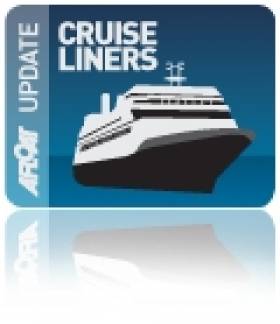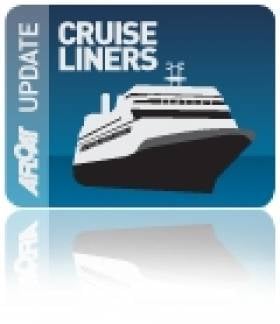Displaying items by tag: Cruisecalls
Cruise Giants to Meet off Cobh
For the first time two cruiseship giants are scheduled to depart and arrive off Cobh at the same time this May Bank Holiday weekend, writes Jehan Ashmore.
The largest cruiseship to call to an Irish port the Independence of the Sea which weighs 154,407 gross tonnes (some 6,000 tonnes larger than the liner Queen Mary 2) will pass the Cobh-berthed Celebrity Eclipse of 122,000 tonnes around 14.00hrs on Sunday.
Weather permitting the Independence of the Seas will then be maneuvering in the swinging basin between Haulbowline and Cobh, just upriver of the Celebrity Eclipse which will then begin to pull away from the deepwater berth at the Cobh Cruise Terminal.
The 350m long berth has a quayside depth of 9m and is capable of handling some of the largest cruiseships on this island.
Prior to Sunday's sailing spectacle the Celebrity Eclipse is due to dock tomorrow afternoon for the overnight call. Likewise the 4,375 passenger Independence of the Seas will stay at Cobh for an overnight call and then depart's on Monday evening.
“Two such large cruise liners, have never before been in Cork Harbour at the same time, let alone pass each other creating a magnificent sight. An excellent viewing point for anyone planning on visiting Cobh on Sunday 1st May would be the High Road or Whitepoint in Cobh” said Port of Cork Commercial Manager, Captain Micheal McCarthy.
Together the cruiseships will have a combined gross tonnage of nearly 300,000 tonnes and they will bring 10,000 passengers and crew into the Cork region this weekend alone. Celebrity Eclipse is operated by Celebrity Cruises and the Independence of the Seas is run by Royal Caribbean International.
The 3,129 passenger Celebrity Eclipse made her 'maiden' cruise and port of call to Cobh last year following her high profile repatriation voyage from Spain with stranded UK tourists arising from the fallout of the Icelandic volcanic ash-cloud.
On that inaugural ocasion the Celebrity Eclipse which cost €500m became the 500th cruise caller to the Port of Cork where the vessel made an overnight call at Cobh. To see a time-lapse video marking the 500th cruiseship's arrival click here.
Prince Albert II of Monaco to Visit Marine Institute
Prince Albert's visit to the Marine Institute headquarters in Oranmore will be held on the final day of the visit on 6 April. Prior to that the prince will hold meetings with An Taoiseach, Enda Kenny, minister for the marine, Simon Coveney, minister for the environment, Phil Hogan and Dublin's Lord Mayor, Gerry Breen.
The Head of Monaco will open an exhibition in honour of his late mother at Farmleigh House and the prince will host a reception to highlight Irish literature and art. In addition to honouring the royal visit a state dinner will be held by President Mary McAleese.
The world's second smallest state is home to the Musée Océanographique de Monaco which has an impressive collection of aquariums. Though the principality is more synonymous with the hosting of Formula 1 Grand Prix. The event is at the end of May and is expected to attract a higher than usual number of cruiseships totalling 12 cruise-calls.
Mostly they will be on charter and accompanied by mega-yachts which are to dock at the outer pier or anchor offshore and along the French Riviera at Villefranche, Nice and Cannes. At the far side of summer Monte Carlo's Port Hercule is also to host the Monaco Yacht Show in September.
- Newport
- Marine Institute
- Co. Galway
- Monaco Yacht Show
- Cruiseships
- Ports and Shipping News
- Oranmore
- Galway Bay News
- Cruisecalls
- Prince Albert II
- Prince Albert of Monaco
- Prince Rainier III
- Princess Grace
- Grace Kelly
- Hollywood
- Port Hercule
- Principality
- Co.Mayo
- Charle Wittstock
- Formula 1
- Grand Prix
- Megayachts
- Musée Océanographique
Cruise-Callers Set to Start Summer Season
Dublin Port last year had 88 cruisecalls and this number of vessels is to be closely repeated in 2011. One of the calls will be Princess Cruises 3,100 passenger Grand Princess. This was the first cruiseship of over 100,000grt to dock at Dublin which arrived on 31 August 2004 (click for photo on the day) and to read more about the cruiseship industry in Ireland from the IMDO click here.
Outside the capital the following vessels outlined are the first cruiseships to call at other ports in April. The season runs to September, though in recent years occasional calls are still made up to November.
The first cruise-caller at Waterford is Quark Expeditions adventure exploration vessel Ocean Nova. At only 2,118 tonnes the diminutive vessel is only 73m long and equally has the same number of passengers and a crew of 38.
Built in 1992 the polar adventure vessel has an ice-strengthened hull to enable the exploration of the icy waters of Greenland, the Weddell Sea and the Antarctic. A pair of Zodiac craft are provided for shore-landings.
The hosting of the Waterford Tall Ships Race Festival has led to funding of €1.7m from Failte Ireland to upgrade the city-centre's Frank Cassin Wharf. This will allow the large 'A' class tallships to berth and will be a lasting legacy of the festival. The wharf will then be used to berth cruiseships and other marine users. In total the crystal city is to welcome 12 callers to include the Crystal Serenity in July.
Cork is set to welcome 54 cruisecalls to include the return of the Cunard Line's 90,000grt Queen Victoria which made her first call to Cobh last year. The 2007 built vessel has a guest capacity for 2,000. The Cunard flagship Queen Mary is scheduled mid-September.
The deepwater berth at Cobh Cruise Terminal is capable of handling some of the largest cruiseships and which will see the return of the 122,000grt Celebrity Eclipse also in April.
Celebrity Eclipse made her maiden cruise and port of call to Cobh last year following her high profile repatriation voyage from Spain with stranded UK tourists arising from the fallout of the Icelandic volcanic ash-cloud. The 2,850 passenger €500m cruiseship which made an overnight call at Cobh during the May Bank holiday weekend.
From the south to the north at Belfast, the port's first caller on 24 April is the Ocean Nova which makes another appearance on the Irish cruiseship scene.
Belfast Harbour Commissioners have developed the 1km long Stormont Wharf to attract increasingly larger cruiseships to the city. The Ocean Nova's visit will mark over a dozen years since the first cruiseship docked in the northern capital.
In 2011 Belfast is scheduled to accommodate 30 cruise-calls bringing over 50,000 passengers to the city and surrounding environs.
































































